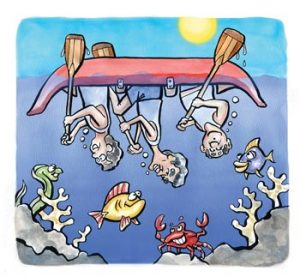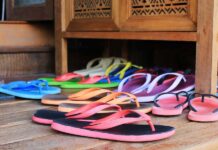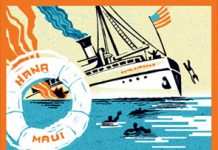Story by Tom Stevens | Illustration by Guy Junker
 In 1952, the year I turned six, islanders involved in any way with ocean sports turned their collective gaze toward West Moloka‘i.
In 1952, the year I turned six, islanders involved in any way with ocean sports turned their collective gaze toward West Moloka‘i.
There, three courageous outrigger canoe teams set out early one morning to revive the old Hawaiian tradition of long-distance paddling. Their quest: cross the dangerous channel between Moloka‘i and O‘ahu.
When the first canoe reached Waikiki hours later, all Honolulu cheered the winning crew of that forty-mile race. “Someday, that’ll be us,” my neighborhood gang agreed. Using materials at hand, we built a crude two-person canoe from scrap wood, road tar and roofing tin. We used palm-frond butts for paddles. As I recall, our window of buoyancy was very brief.
Fifty years would pass before I found myself seated in a real canoe for the start of my first “distance” race. The finish line lay a mere nine miles away, but I really didn’t want to race at all. I just wanted to paddle, glide along and see the sights.
I couldn’t share that outlook with my teammates, of course, because canoe racing is fiercely, gut-wrenchingly competitive. So in that race and in the few others of my short-lived distance career, I had to try to look fierce and gut-wrenched.
I might have complained about this, but ancient protocols allow only the steersperson to utter complete sentences. The sentence most often directed my way was, “Tommy! Keep your head in the boat!”
This seagoing code of omertá always made me a little wistful, because there was so much to remark upon. One time, during a twelve-mile race off Kaua‘i, a big barracuda burst from the sapphire sea and tail-walked for a few beats alongside our canoe.
“Yaaahhh!” I shouted. “Did you guys. . . .”
The paddler ahead of me did not turn or speak, but his neck thickened and his head tilted forward in annoyance. This brought into my view plane the motto stitched onto the back of his ball cap: “Shut up and paddle.”
Even with conversation muzzled, I found distance paddling to be rich in diversions. In addition to tail-walking barracudas and frolicking dolphins, most courses also offer peerless mountain and shoreline views you’re not supposed to notice from the boat.
On Maui alone, yearly distance races send paddlers past rugged Kahakuloa, along the colorful Lahaina Pali, and down the scenic East Maui coast. One Hana race even circles Alau Island. How can you not look at that?
Temptation peaks when races are held on other islands. There, host crews accustomed to “home waters” hope visiting paddlers will be distracted by the new scenery. I was always happy to oblige.
Thus, breathtaking stretches of Kaua‘i, O‘ahu, Moloka‘i and the Big Island scroll past the canoe in gorgeous slow motion. But you’re not supposed to look, because a carelessly turned head can huli (overturn) the canoe.
So can circumstances beyond your control. That happened near the end of one Maui race, a twenty-miler from Ma‘alaea to Ka‘anapali. Wanting to savor fully a sunny day on the water, our team of fifty-somethings elected to paddle the distance “iron” style, meaning without crew changes.
Sunburn and weariness aside, our strategy worked well until we reached the Lahaina break wall. There, a backwash churned up by speeding escort boats toppled our canoe. In an instant, we found ourselves seated upside down, under water.
Though this quenched any hopes for a respectable finish, we did not scramble to right the boat. We stayed under for some time, our paddles motionless in our hands.
I remember it was cool and comfortable down there, and the sightseeing was terrific.





